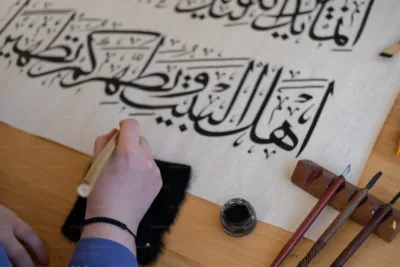The History and Significance of Naskh Calligraphy in Delhi
Image Source: Unsplash
Persian calligraphy has been a part of the Islamic tradition and culture for ages, deeply revered and influenced the Indian subcontinent during the Mediaeval period. Many scriptures were developed in Arabic and Persian calligraphy, amongst which ‘Naskh’ is the most prominent and was known for its utility, elegance, and understanding. It continued the heritage of the Mughals, and the Islamic culture in Delhi.
Origin and development of the Naskh Script
Naskh which means ‘to copy’ in Arabic originated in the 10th century CE as a calligraphy style. It was developed by ‘Ibn Muqlah’ a famous Persian Calligrapher during the Abbasid Caliphate – who had laid the rules for script writing, which became the standard for Arabic and Persian writing.
Naskh script was fluid, and easy to read, which is why it was used in copying manuscripts, especially in the Quran. It became the script for book production and was highly revered in Persian literature. Naskh eventually became widely popular spreading to the Middle East, Central Asia, and the Indian Subcontinent.

Image Source: Daily Sabah
Introduction of the Persian Calligraphy in India
By the 13th century, Persian influence had taken over the Indian subcontinent and many Emperors who had Persian origins brought their language, culture, and the art of calligraphy to India. Persian also became the court language and was incorporated into the artistic traditions of that time.
The Mughals that succeeded the Delhi Sultanate deepened the Naskh script – Emperor Akbar, Jahangir, and Shah Jahan were even great patrons of the Naskh script and flourished in the court, becoming a part of the literary culture of that time.
There were different styles of the Naskh script with various fonts adopted from other parts of the world namely from the North-Africa and the Middle East to Central Asia. Some of the major fonts and styles were:
- Ottoman Naskh: Between 1299 and 1922, Naskh went through many changes, the Ottomans created a more distinctive script, with elongated letters. This version of the Naskh later went on to be used in official documents in the Ottoman period.
- Iranian Naskh: Iranian calligraphers made their version of the Naskh more dense than the Ottomans with space between letters and thicker strokes. During the Safavid rule (1501-1736) the Iranian Naskh was used in miniature paintings and for artwork.
- Maghrebi Naskh: Present-day North Africa – Morocco, Algeria, Tunisia and Libya, characterised by its angular letters, loops and curves. Maghrebi Naskh consists of geometric qualities and was influenced by the Kufic script in the region. Maghrebi was also used in the copy of the Quran, and other religious texts.

Image Source: Ella(Medium)
Naskh script in the architecture of Delhi
Islamic architecture is one of the most important legacies of the Naskh script found in Delhi. The Islamic tradition was known for its grandeur architecture, and calligraphy which played a significant role in conveying the Quran verses, and messages through writings.

Image Source: Stephen Blog
- The Naskh script is seen adorning the walls of tombs, and madrasas in Delhi with the verses of a royal decree, the Quran, and spiritual messages inscribed.
- Jama Masjid which was commissioned by Emperor Shah Jahan in the 17th century has Naskh script intricate on its walls, and domes.
- Red Fort in Delhi is another example constructed during the reign of Shah Jahan. The inner sanctum of the fort, especially the Diwan-i-Khas (hall of private audience) has Naskh calligraphy which is beautifully illustrated, showcasing the tradition of Persian calligraphy and the vision of emperors to integrate the Indian diaspora with the Persian culture.

Image Source: Wikipedia
- The Humayun’s Tomb built in the middle of the 16th century has the Naskh calligraphy in the form of decorative tiles and carvings. The famous mausoleum was an inspiration for the Taj Mahal showcasing the Central Asian, Persian, and Indian fusion.

Image Source: Wikimedia Commons
The Role of Naskh Script in Persian Literature and Manuscripts
Delhi was the hub for literary activities during the medieval period. At the same time, the Naskh script was preferred for book production and writing because of its clarity. Manuscripts were written in the Mediaeval period and numerous calligraphy copied religious texts, and biographies and wrote them in the Naskh script while illuminating it with gold and beautiful designs.
One of the most famous examples of work written in the Naskh script is the Padshahnama chronicle of the reign of Emperor Shah Jahan. It was produced by court historian Abdul Hamid Lahori and illustrated in elegant calligraphy. It is an outstanding piece of literature and art of the Mughal period.
The Decline and Revival of the Naskh Calligraphy

Image Source: Artnet
After the end of the Mughal Empire by the 18th century and the advent of the Europeans especially the British, Persian calligraphy slowly lost its importance in Delhi. The Britishers introduced English as the administrative language and Persian slowly faded away. But a small community of calligraphers did not let it disappear and passed it on to the next generation.
In the modern world, Persian calligraphy has been revived, particularly the Naskh script. In Delhi, Islamic art and heritage have been greatly appreciated and emerged in National Museums, and the National Archives. These institutions have preserved calligraphy, and manuscripts making them easy to be accessible.
To keep Persian calligraphy alive, workshops and exhibitions help in the fusion of classic art with new forms of script writing techniques. As Delhi evolves, the legacy and history of the Naskh calligraphy brings the city’s deep connection with history and the contribution of the Persian language to the country.
Recent Stories
- Paithani: The Silky Indian Handloom
- From Florence to the Taj Mahal: The Global Journey of Pietra Dura
- The History of Guldaudi Patterns in Delhi – A Legacy of Floral Art and Craft
- Chundan Vallam- An ancient naval craftmanship withstanding the test of time
- The History and Significance of Naskh Calligraphy in Delhi
- Why Rajput Painting is a Treasure of Rajasthan’s Art Scene
- The Timeless Art of Chikankari: Embroidery of Elegance and Heritage
- Zari Zardozi: The Golden Thread of Delhi’s Heritage
Products
-
 Wooden Wall Platters - set of 2
Wooden Wall Platters - set of 2
₹999.00Original price was: ₹999.00.₹599.00Current price is: ₹599.00. -
 Chalice - Premium Wood
Chalice - Premium Wood
₹899.00Original price was: ₹899.00.₹399.00Current price is: ₹399.00. -
 Wooden Table Vases - set of 2
Wooden Table Vases - set of 2
₹1,599.00Original price was: ₹1,599.00.₹399.00Current price is: ₹399.00. -
 Small Table Vase - Wooden
Small Table Vase - Wooden
₹889.00Original price was: ₹889.00.₹299.00Current price is: ₹299.00. -
 AshTray - Premium Wood
AshTray - Premium Wood
₹1,399.00Original price was: ₹1,399.00.₹399.00Current price is: ₹399.00.









